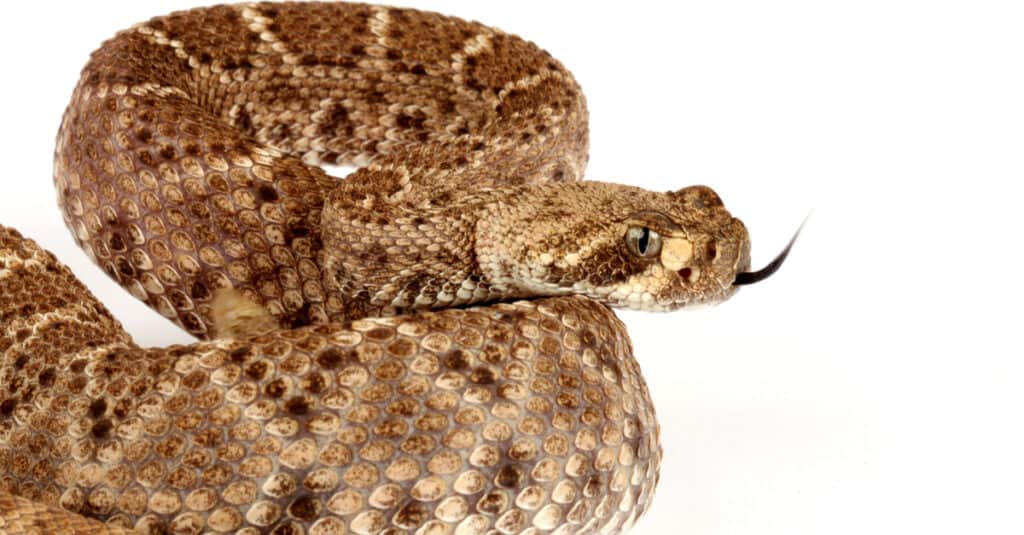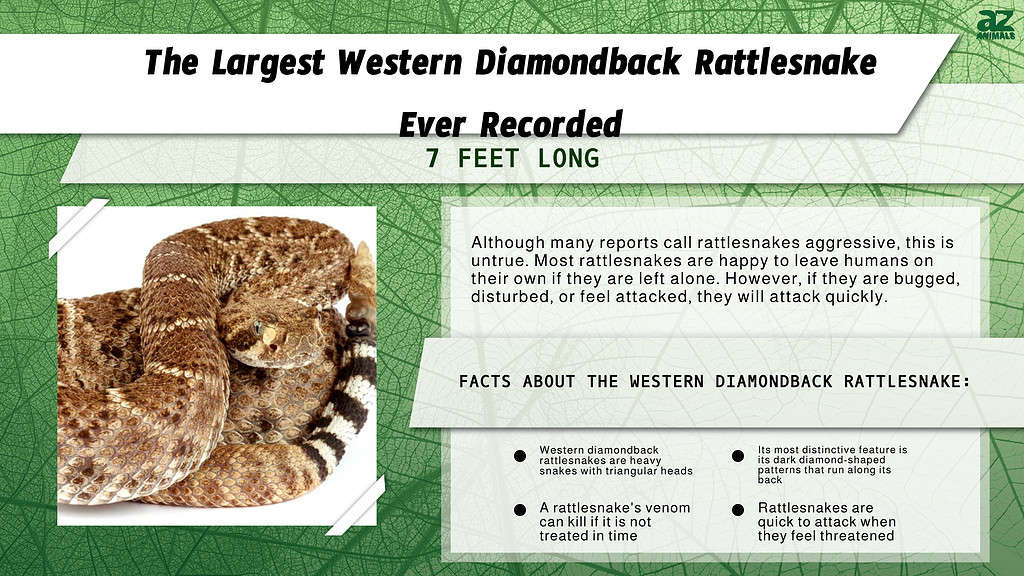Western diamondback rattlesnakes are found in the southwestern parts of the United States as well as northern Mexico. These snakes are mostly found in desert or semi-desert areas. Like many other rattlesnakes, western diamondback rattlesnakes are very venomous. Their venom contains hemotoxins that affect blood cells, and blood vessels, and induce hemorrhaging.
On average, western diamondback rattlesnakes measure 4 feet in length. In rare cases, some that are up to 5-feet long are encountered. In this article, we’ll take a look at the largest western diamondback rattlesnake ever recorded. Its size will surprise you.
What is the Largest Western Diamondback Rattlesnake Ever Recorded?

The largest western diamondback rattlesnake ever recorded was 7 feet.
©Audrey Snider-Bell/Shutterstock.com
According to reliable reports, the largest western diamondback rattlesnake ever recorded was 7 feet. We say “reliable reports” because the record was registered by Laurence M. Klauber, San Diego Zoo’s first Curator of Reptiles, who was internationally recognized for his knowledge and achievements in the field.
There are several claims on the internet of western diamondback rattlesnakes as large as 15 feet. However, they are unreliable and most likely false. This is because even 6-foot western diamondback rattlesnakes are hardly ever seen.
What is the Largest Rattlesnake Ever Recorded?

The largest rattlesnake ever caught was an eastern diamondback rattlesnake that measured 7 feet 8 inches in length.
©Chase D’animulls/Shutterstock.com
According to the Guinness Book of World Records, a person, identified by only the singular name Rutledge, holds the record for the largest rattlesnake ever recorded. The record was entered in 1946 and stated that an eastern diamondback rattlesnake measuring 7 feet 8 inches in length was shot by Rutledge who was a hunter. It also weighed 34 pounds.
It isn’t much of a surprise that the largest recorded rattlesnake was an eastern diamondback. This is because they are known as the largest species of rattlesnakes.
How to Identify Western Diamondback Rattlesnakes

The western diamondback’s most distinctive feature is its dark diamond-shaped patterns which run along its back.
©Alexander Wong/Shutterstock.com
Western diamondback rattlesnakes are heavy snakes with triangular heads. They are usually colored with mixtures of brown, yellow, brick red, and pinkish or yellowish-white. They have two dark diagonal lines that run down from their eyes to their jaws.
The species’ most distinctive feature is its dark diamond-shaped patterns which run along its back. Its tail has black and white bands that are followed by the rattles.
What State has the Most Rattlesnakes?
Arizona is known to house the most rattlesnakes in the US. They have the most number and the most species. Arizona’s rattlesnakes spread across the whole state.
Can a Rattlesnake’s Venom Kill You?
A rattlesnake’s venom can kill if it is not treated in time. However, most people are able to obtain medical attention before it is too late. Hence, their bites are dangerous and can be fatal but hardly ever are.

How Do Rattlesnakes Defend Themselves?
Rattlesnakes have ample ways to defend themselves in the wild. Not only can they make use of their venom, but they can also make use of their musk. They also rattle their tails to announce their presence and warn their predators or distract them. Rattlesnakes are quick to attack when they feel threatened.
What is the Difference Between a Rattlesnake and a Copperhead?
Although copperheads and rattlesnakes are pit vipers and have similarities, they are different species. One of the major differences between these two snakes is the rattle. Rattlesnakes have rattles and copperheads do not. Another difference is in how they react to attackers. A rattlesnake will coil up, rattle its tail, and prepare to attack. A copperhead, on the other hand, will go completely still.
Do Rattlesnakes Make Good Pets?
For the average person, a rattlesnake is not a good pet. Only experts with years of experience should keep rattlesnakes as pets- and a lot of them don’t. They are particularly frowned upon because they are dangerous to keep if children, pets, or elderly persons live close by.
Are Rattlesnakes Aggressive?
Although many reports call rattlesnakes aggressive, this is untrue. Most rattlesnakes are happy to leave humans on their own if they are left alone. However, if they are bugged, disturbed, or feel attacked, they will attack quickly.
Facts About Western Diamondback Snakes
Here are some of the most amazing facts about western diamondback snakes:
- Up to 800mg of venom: On average, western diamondback’s bites contain between 250 and 350 mg of venom. However, sometimes, their venom yield could go up to 800mg. It takes only seconds for the rattlesnake’s venom to travel into its victim’s bloodstream. Bitten persons can begin to experience its effects immediately.
- 20-year life expectancy: In captivity, western diamondback rattlesnakes can live for up to 15-20 years.
- Keratin rattles: Rattlesnake rattles are one of the species’ most prominent features. However, not many people know that the snake’s rattles are actually made of keratin. In case you didn’t know, your fingernails are made of keratin.
- Their rattles grow: Each time a rattlesnake sheds its skin, it adds a rattle segment. However, segments often break off so they cannot be used to approximate age.
- Facial pits: Like all pit vipers, rattlesnakes have facial pits. They are often mistaken for another pair of nostrils but they are not. They are heat-sensing pits that help them detect movements. This helps them avoid predators and hunt prey.
- Squirrels use their perfume: Believe it or not, squirrels are often on the lookout for the shed skin of rattlesnakes. When they find it, they chew on the skin and then lick their fur, thereby coating themselves in the rattlesnake’s perfume. They use this to smell dangerous and less attractive to predators.
- Rat snakes mimic their rattles: Often, rat snakes mimic rattlesnakes. They do this by vibrating their tails to appear as rattlesnakes and scare off predators.
- Baby rattlesnakes are still dangerous: A popular myth states that baby rattlesnakes are more venomous than adults. This isn’t true although baby rattlesnakes are venomous.
- They don’t eat often: Rattlesnakes can eat as infrequently as once in two weeks.
Look-Alikes
Reptiles are quite unique in their ability to adapt. One amazing example of this adaptation is how non-venomous snakes have evolved over time to resemble physically and characteristically venomous, dangerous species living in the same regions as they do. Gopher snakes are a prime example of a look-alike of rattlesnakes, especially diamondbacks. These snakes have diamond patterns and similar colorations to the mentioned rattlers, helping them ward off predators. Additionally, gopher snakes will curl up and strike out, closed-mouth, to act like a rattlesnake striking in defense. In actuality, these snakes are harmless snakes that use constriction as their method of predation instead of deadly venom.
Other Record-Breaking Snakes

The pine snake is easily identifiable by its small head.
©iStock.com/alex grichenko
The largest pine snake ever recorded measured a staggering 8.75 feet in length, making it one of the most impressive specimens in the world of herpetology. Pine snakes are known for their striking appearance and can be found throughout North America, where they inhabit a variety of different habitats, such as forests and grasslands.
Although there have been many large pine snakes documented over the years, this particular individual set a new record that is unlikely to be surpassed any time soon. Pine snakes are non-venomous and generally not considered dangerous to humans, but they can still pose a threat if provoked or cornered.
Despite their size and strength, these beautiful creatures are often threatened by habitat loss and other human activities that encroach on their natural habitats. As such, conservation efforts aimed at protecting pine snake populations have become increasingly important in recent years.
The photo featured at the top of this post is ©
Discover the "Monster" Snake 5X Bigger than an Anaconda
Every day A-Z Animals sends out some of the most incredible facts in the world from our free newsletter. Want to discover the 10 most beautiful snakes in the world, a "snake island" where you're never more than 3 feet from danger, or a "monster" snake 5X larger than an anaconda? Then sign up right now and you'll start receiving our daily newsletter absolutely free.
Thank you for reading! Have some feedback for us? Contact the AZ Animals editorial team.






